|
John Bondhus founded the North American Native Fishes Association (NANFA) in 1972. This article appeared in the Fall 2002 American Currents, NANFA's 30th Anniversary issue (at right) |
 |
Christopher Scharpf, our devoted and professional
American Currents editor,
and Jay DeLong, the driving force behind the NANFA web page, pestered me
for some time to write a history of NANFA. I knew it
would take a lot of time to write, and time is very dear to me at this point in my life. I have a
wonderful second family with two children, five and seven, who need more
time and energy than this 58-year-old can easily find. Fortunately, I
have a wonderful wife who helps keep my life in
balance. For the past 40 years I've
been running a small multinational sales and marketing company, which I
founded. We sell hand tools in over 40 countries, with a sales office in
Japan and manufacturing plants in the U.S. and Barbados. The current
state of the economy has created a workload that
greatly defines my time. In spite of these time
constraints, both Chris and Jay are right:
This article is important and the time is right. It's
NANFA's 30th anniversary!
The main objective of this article is to relate the history of NANFA from the perspective of its founder. I have a second and equally important objective, which is to encourage more involvement from you, the members. You see, NANFA has never been an organization that depends upon one person. Yes, I was very involved, especially during the early years. However, my contributions alone would not have made NANFA what it is today. There have been scores of very dedicated volunteers who devoted countless hours to the association. While there are too many people to mention them all, the ones I do mention have each spent many hundreds of hours defining and improving the association and its mission. They, like me, have done this not just for the sake of NANFA, but because it satisfied a deeper personal need: the need to learn and share what we've learned.
The Early Years: 1972-1976
|
It has been 30 years since our first American Currents was published in
the fall of 1972, a simple, folded 8-1/2" x
11" paper format of 26 pages
with no volume number. Vol. 1, No. 1 started in the spring of 1973.
It had the same logo developed by John R. Quinn (wildlife artist and
later editor of Tropical Fish Hobbyist) that is
often used today. Vol. 1, No. 1 contained several
interesting articles with black and white photos, and a
list of 48 NANFA members and officers. The officers included myself
as president, H. Ross Brock, Jr. of Georgia as
treasurer, Frank Fuqua of California as librarian,
Dick Stober of Alabama in charge of the Trading
Post, Harry Abrams of Indiana as membership chairman, and eight other
positions. These were all self-appointed volunteers as no formal
elections or Board had yet been established.
All of these officers worked hard to make the organization a reality.
Some deserve special mention as they worked tirelessly for many years in many different capacities. Dick Stober served as president, Board Member, American Currents editor for many years (publishing the first color version of NANFA's flagship publication). He also worked hard to develop the Trading Post, and filled in as treasurer when asked. Frank Fuqua worked several years as librarian, and editor of American Currents starting in 1974. Bob Rosen of New Jersey was another active member. Although Bob was not one of the first officers, he later served as president, vice president, treasurer, and membership chairman, and helped with other projects. |
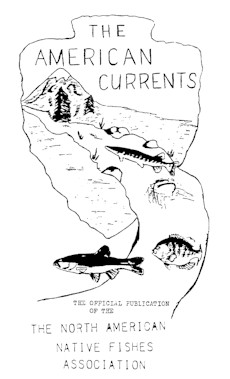 Cover of the first American Currents, Fall 1972. The issue had no publication date or volume number. The current volume numbering system began with the next issue and continues to this day. |
Four issues of a well-organized American Currents were published in 1973. In the first one of that year, Ray Katula published his first of many articles. Ray later went on to serve in many positions in the club and ultimately became a NANFA Fellow for his contributions. Other members that joined before the spring issue was printed included Gerry Corcoran of Mississippi (our only deceased NANFA Fellow) and R. Bruce Gebhardt of Pennsylvania, one of NANFA's most active members.
|
In the summer of 1973, while we were still under 100 members, we had our
first convention. It was held in New Jersey and included a collecting
trip to the New Jersey Pine Barrens. Six members
participated, including Bob Rosen and John Quinn.
It is probably the only thing I did in 1973 that I can
still remember! I have many fond memories of that trip. In 1974, telephone costs were high and most members didn't have enough money to regularly make long-distance telephone calls. Thus we started an active member list and distributed copies of all useful club correspondence to the Board of Directors and anyone who requested to be involved. It functioned somewhat like the current Board e-mail list, but all the items were typed on single sheets of paper, arranged by topic, photocopied, and mailed to active list participants. While this took a lot of time, it accomplished the important task of keeping members informed of what was happening so choices could be made as a group, not by one individual. We had our first elections and appointed our first elected Board in 1974. I stepped down and became secretary as Dick Stober assumed the presidency. In 1976, Bob Rosen was elected president, and Dick Stober became treasurer, among other duties. |
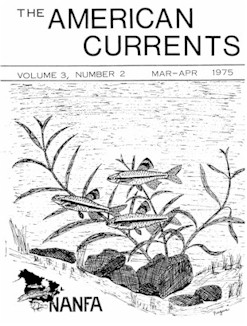 A cover from 1975, illustrated by editor Frank Fuqua, showcasing a Dick Stober article on the flagfin shiner. The "The" in American Currents was dropped in 1977. |
Years of Growth and Change: 1977-1995
| The year 1977 saw Bill Scoggins assume the presidency, and Dick Stober took over American Currents. Dick found a local printer who published the magazine with full-color covers of many different species. To us at the time, color in our publication was exciting, and we were very disappointed when the printer went out of business in 1978. That year was also the first year NANFA members started attending the annual Weekend Winter Workshop, which was a regional convention of aquarists of many areas of interest, including native fishes, held in the Southeast. The NANFA members who attended got together during those meetings for many years in many cities. I attended one of those meetings and remember many lively discussions, some which lasted until 4 a.m. That meeting was held in Macon, Georgia, and they got 1-1/2 inches of snow on the last day of the workshop. The entire city shut down, including the freeway and airport. The convention lasted a day longer than planned because there was no way to get anywhere until the snow melted! |
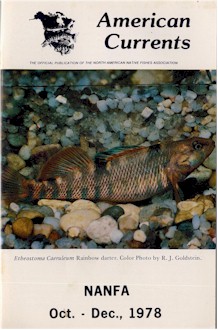 One of Dick Stober's color covers from 1978. |
|
In 1978, Gerry Corcoran started publishing a newsletter,
Lateral Line, in
addition to American Currents. Its purpose was to provide a
more timely source of information to members, and it was typically mailed
between issues of American Currents. It contained a small sampling of
articles, the Trading Post, the membership list, and short newsworthy
items. Gerry continued Lateral Line until the middle
of 1982. He not only edited the newsletter, he also
printed and mailed it. I think most of this was at his
expense. Gerry was one of NANFA's most dedicated members. He wrote many
articles for American Currents, served in many capacities where needed,
and was president in 1979. The Gerald C. Corcoran
Education Grant is named in his honor and memory. |
|
The same year Gerry became president (1979) also saw Bill Scoggins of California take over as editor of American Currents. Bill also helped in many other capacities including later serving as president. Bruce Gebhardt assumed the presidency in 1982. Bruce had been active almost from the beginning and wrote many articles for American Currents. John Eccleston became editor of the publication and continued for most of 1983. John must have had a tremendous amount of energy, since he published American Currents monthly in 1982 and bimonthly in 1983. Bruce Gebhardt then assumed editor duties, and continued as President until 1988. Dave Hall of California (now Texas), became president from 1988 until 1991, but Bruce continued editing American Currents until 1994. |
 John Eccleston became editor in 1982 and produced many fine issues. Many covers from this period, including those for Lateral Line, were illustrated by Errol White of Biloxi, Mississippi. |
| Dave started some initiatives to get more member involvement and
suggested starting another newsletter. Not all of his suggestions were
accepted, but Dave did get NANFA regional chapters started and many of
these have been quite successful. In 1991, Ray Katula,
another very active member and frequent contributor to
American Currents since the first year, became
president until 1994. Ray also worked hard to get more members involved. In 1995, I renewed my interest in NANFA and again became president. I had two major objectives: to increase member participation, and to get NANFA more involved in endangered fish conservation projects. The Board reestablished the Lateral Line newsletter under the name Darter, and it was capably edited by Konrad Schmidt for several years. When Konrad became too busy in his work he stepped down and the newsletter was again dropped, but by this time the NANFA webpage and email lists were up and running so communication within the club did not suffer. |
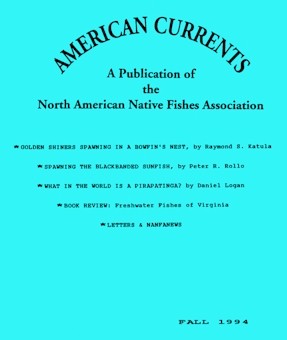 Bruce Gebhardt edited American Currents from 1984 through 1994. His covers were rarely eye-catching, but the contents were always well edited and full of quality information. |
Building Today's NANFA: 1996 to
Present
Robert Rice assumed the presidency in 1996, and he did an
exceptional job as membership chairman, bringing in many new members. He
wrote many articles for American Currents and for other publications on
the condition that they mention NANFA in the text.
There was a serious power struggle within NANFA between 1995 and 1996,
which ended with Bruce Gebhardt leaving the organization. Bruce may have
been the most active member NANFA ever had, and the club misses him.
Needless to say, NANFA is an organization that gets its strength and
value from the contributions of many members, not just
one, and I truly believe the club is much stronger
today.
|
I believe the explosive growth in member
services and involvement since that time shows this clearly. Every year
since 1996 we have held annual meetings, in part due to a more active
membership.
In 1997, Christopher Scharpf became editor of American Currents and continues to do an excellent job to this day. Jay DeLong started the NANFA web page that same year and continues to manage the site. Another very useful program is the NANFA e-mail list, begun around the same time by fellow Oregonians Norman Edelen and Dan Logan. More recently, NANFA launched two grant programs to fund conservation research and educational outreach projects. Funded by convention profits, donations, and a $5 dues increase, the two programs have in just two years awarded over $4700 in grant monies. |
 Computers and desktop publishing software transformed American Currents. This is the first issue designed and edited by Christopher Scharpf. Despite the date, it was actually the first issue of 1997. |
People often ask me if I am proud of what NANFA has become, and if I
really believed it would ever evolve into the type of organization it is
today. I can say with certainty, Yes, I am very proud of NANFA, and of my
contribution in getting it started. I worked very hard during those first
10 years, which gives me a tremendous sense of
satisfaction. I am especially pleased that NANFA
functions just as well, if not better, without my help,
and that it continues to provide satisfaction to its members 30 years
after it began.
Basically, NANFA met an unfulfilled need (and likely would have been
started by someone else had I not done it first). In fact, this need is
probably the key reason we get so many dedicated volunteers, and why they
work so hard to keep it going.
NANFA represents different things to different people. It's
a source of information and an opportunity to share
expertise. It's a forum to trade
fish that are almost impossible to get any other way. It's
a way to improve the environment for native fishes.
And it's a way to meet other fish experts and people
who are equally crazy about fish. I fondly remember the national
fish conventions I attended where we stayed up into the wee hours of the
morning excitedly talking about a topic almost no one else would want to
discuss for more than a few minutes!
For me, this kinship is greater than any I experience in most other
areas of my life. It is one of the unexpected gains I really appreciate
about NANFA. As I said, someone almost certainly would have established
NANFA, but since I was the one who did, I'd
like to share some of my reasons for doing so with
you. In a way, you could say the following represents a "pre-history"
of NANFA, going back 15 or so years before the start of the
organization, when I was in my early teens.
How I Got Into Natives
I became interested in fish when I visited a pet shop with my parents
and my Dad bought a five-gallon tank of tropical fish. It was a community
tank, and I was truly fascinated by watching nature right in front of my
eyes. I bought a small softcover book, A Guide to Tropical Fish by N. H.
and S. K. Mager. It listed about 200 species, and I
thought it covered them all. I read the covers off
this book. Then, when I watched one of the guppies in
my tank have babies, I was hooked on fish for good.
I bought most of the books that Innes and Axelrod had written at the
time, and started reading Tropical Fish Hobbyist. I dreamed of owning a
fish farm in Florida, and joined a fish club in
Minneapolis. I tried raising most of the fish that
were within my budget. I never could justify paying over $3
per fish, which more than 90% of the species cost at that time.
Unfortunately, I was too cheap to pay more and too lazy to raise the young
fish up to full size in order to sell them back to the pet shop to recoup
my investment.
One day, as I was out looking in a small stream that led into a large
swamp named Mud Lake, near Orrock, Minnesota, I caught some central
mudminnows (Umbra limi). I was totally fascinated. They looked
like nothing in my books, and I thought I must have
discovered a new species. I did a little more research
and finally found a book called Northern Fishes by
Samuel Eddy. It was all about fish from Minnesota. All of a sudden my focus
changed! I now found that there were many species right in my own area
that were "new"
and interesting. I also discovered that the University of
Minnesota had a library with hundreds of books on native fishes from
around the country. Not only were these fishes
different, they were also cheap, challenging, and I
could study them without straying far from home. I soon
learned there was a lot of scientific literature on Minnesota's
native fishes, and it was all written in English. It
even occurred to me that they could be raised on a
fish farm in Minnesota.
| I still kept tropical fish, but I grew less interested in them. I kept my North American natives in the same tanks as my tropicals, despite pet store warnings that you couldn't do that without losing your tropicals. (It's amazing to me that pet shop employees still say this.) You can keep fish from Africa, South America, Asia, and Australia in the same tank, but North American fish are supposed to be harmful? I believe this kind of misinformation is one reason North American natives are not kept by more hobbyists today. |
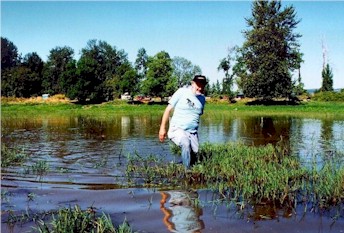 John Bondhus gets his feet (and more) wet at the 1997 NANFA Annual Meeting in Portland, Oregon |
I stayed in my local fish club, but felt more like an outsider all the time. The other members simply couldn't understand why I raised natives and probably thought I was eccentric. That fish club had a yearly fish show that was held in a local shopping mall. The mall paid for all the prizes and trophies, and the show attracted over 200 tanks in about 20 categories. Tanks up to 200 gallons in size were exhibited, and some were quite impressive. In the native category there were usually only four or five entries, usually five or 10 gallons in size. I always won this category with a 50-gallon community tank. One year the club added a new prize category in which mall visitors were asked to vote on the tank they liked best. I made a special effort that year and set up a very attractive 50-gallon tank with a five-inch northern pike (Esox lucius), a four-inch largemouth bass (Micropterus salmoides), a couple of two-and-a-half-inch black crappie (Pomoxis nigromaculatus), a few pumpkinseed (Lepomis gibbosus) and other sunfishes, a small yellow perch (Perca flavescens), a black bullhead (Ictalurus melas), and a few other fishes. My tank looked nice, but there were at least 15 other 50- to 200-gallon tanks that were equally spectacular featuring fresh- and saltwater fishes from around the world. My tank not only won, it got almost 50% of the total votes! People were always walking by saying, "Look at that. That looks just like a big northern pike," or a bass, and so on. I think it was this revelation--that I was not the only person who liked native fishes--that inspired me to start NANFA. My tank got more votes because there were (and still are) more fishermen and all-around nature lovers among the general public than tropical fish hobbyists.
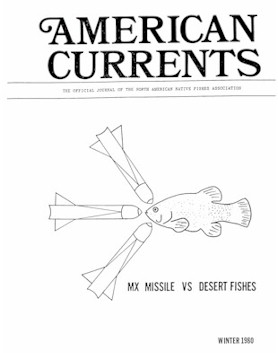 An interesting "political" cover from the days conservationists were fighting developers and the U.S. military to preserve the aquatic desert ecosystems in the Great Basin. |
I believe that more people would keep native fishes if they were as easy to obtain as their tropical counterparts. Even today, I think the market for native fishes remains untapped and could be developed. Personally, I would like this to happen. There are some who say the environmental risks are higher if you raise natives. I agree that native fishes are more likely to cause havoc if released into the wrong habitat. At the same time, it is the knowledge and appreciation for natives I gained while keeping them in aquaria that have turned me into an environmentalist. I believe the educational value of keeping natives more than offsets the risk of an occasional introduction. (Besides, most of the introductions that have occurred were done deliberately by misguided people to control weeds, control other fish, or to provide sportfishing. Future introductions like these would be harder to accomplish if more people better understood the environmental consequences.) |
An appreciation for native fishes also can help protect those that are
endangered. Some species, like the Alabama sturgeon (Scaphirhynchus
suttkusi), have difficulty making it to the endangered species list
because of political pressure from business
coalitions. If we ever want to balance the scales
between endangered species and financial interests, the general
public has to care enough to do something about it. Native fish hobbyists
can play a key role in spreading awareness and fostering a climate of
care.
Sharing, Learning, Conserving
My interests changed. A few decades ago, during a period when I was less
focused on business, I started reading and studying more about native
fishes, and keeping them less. I realized that accumulating all the
information available on a specific fish was almost impossible. I started
to write an annotated bibliography of the pike family,
Esocidae, and hoped that others would do the same with
other species. This project proved too daunting, and I
later abandoned it as my interest in business returned. In
the process, though, I accumulated 5000 references on the pike family on
subjects ranging from disease to distribution to aquaculture. I estimated
that there were another 5000 references, not counting game fish articles,
I still had not accumulated. And that's
for a small family (only five species) back in the
1980s! I estimate there must be twice as many references today.
The job is simply too big for one person, even working fulltime. My
bibliography was never published and remains unfinished.
| While the job of writing about all fish species is an enormous task, it may be possible to complete a large part of it. Through the Internet, many people can share their work and the work can be divvied up as long as there are volunteers to do it. Information on a website does not have to be complete. It is a place to continuously add and refine information as interested members share their knowledge. Even color photos and videos are within the budget of a website. In some ways NANFA's website is doing this already. What we need is someone to develop a species-by-species outline broken down into categories such as breeding and culture information, distribution data, habitat data, etc. Someone would also need to assign passwords to individual contributors wishing to write in their own particular area(s) of interest. We have many members who are clearly the world's foremost experts on certain fishes, and a large percentage of us can contribute specific useful information on something we have observed. Think of the value of going to a resource like this where most of what is currently known would be organized and searchable electronically in minutes instead of days, weeks, or months. Anyone interested in taking on this challenge? |
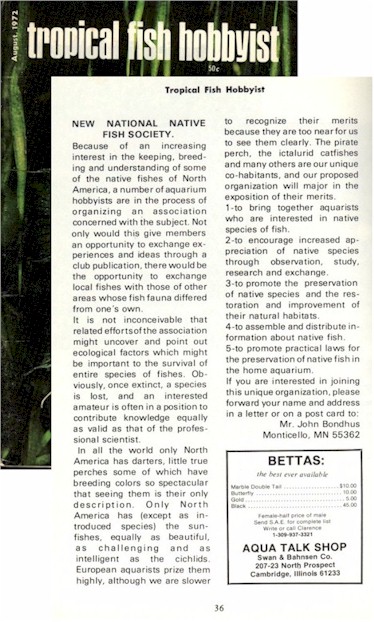 NANFA recruited its first members with this full page advertisement in the August 1972 Tropical Fish Hobbyist. |
Another area I am interested in is endangered species conservation. I
began to organize a conservation program within NANFA, but shortly
thereafter started a new family, and had to stop before I had hardly
begun. NANFA has many members doing a lot of work in
this area, usually as part of their work in other
organizations, but I think a lot could be gained by
enlisting NANFA's help.
One of the unique things I like about NANFA is the breakdown of its
members. Typically, they fall into either governmental, academic, or
amateur hobbyist categories. I think the cross
fertilization among these groups that
NANFA engenders increases the amount of information shared. Most of our
professional members agree they can learn something from amateurs, and
vice versa.
NANFA's Future
The future of NANFA looks exceptionally bright. My personal workload and
family are limiting me, but it really doesn't matter. NANFA is in the
hands of many exceptional people. The last 10 years or
so have seen dramatic growth for the club, not
necessarily in the number of members, but in a more
important area: accomplishing the mission statement goals. I am sure a lot
of people never apply for membership, but does that really matter? It
costs almost nothing for someone to visit our website,
learn from it, and apply its principles.
I just reread NANFA's mission statement, composed in
1998. I agree with it totally and cannot think of a
single improvement. I couldn't have turned
the club over to a more capable team.

